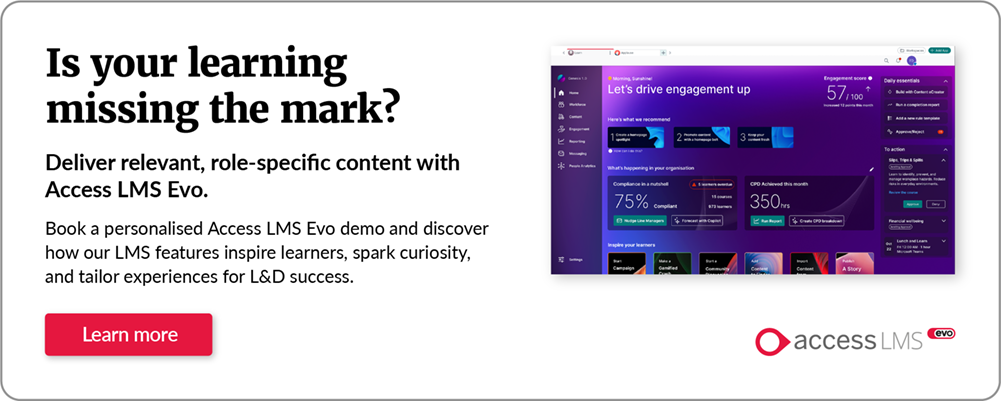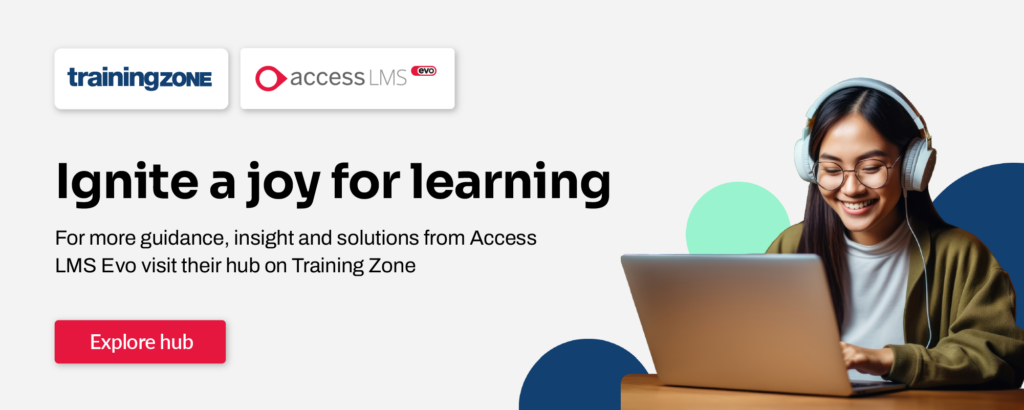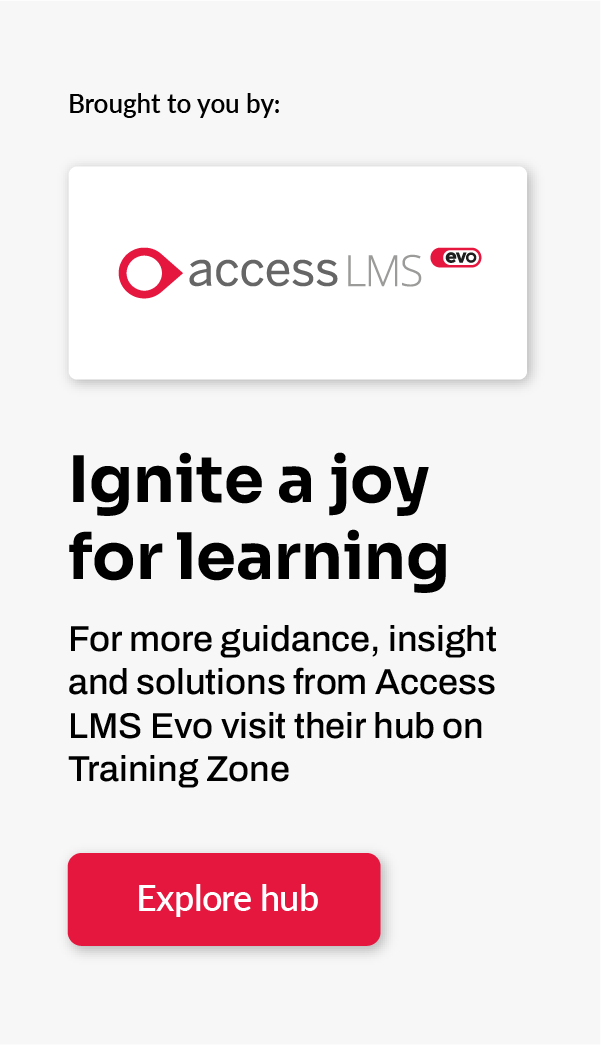Once you’ve selected a Learning Management System (LMS) tailored to your organisation’s requirements, it becomes crucial to gauge the levels of user engagement it brings. Understanding this engagement includes both the system and how users interact with it. This involves assessing uptake of mandatory training requirements for employees while also measuring their inclination towards wider learning initiatives, such as training they choose to undertake.
By delving into these aspects, organisations can effectively encourage greater user engagement with their LMS. Strengthening engagement will benefit both the employee and organisation so it should be on your radar when looking at ways to improve your learning offering.
In this article, we are going to explore:
- Why is LMS engagement important?
- What features should be included to promote LMS user engagement?
- The value of accessible content
- Using learning cultures to encourage LMS user engagement
Why is LMS engagement important?
Firstly, let’s look at why LMS engagement is important. For any size organisation, employee training is vital and user engagement is a measure of how effectively the training is being delivered.
For mandatory topics such as Health & Safety and Cyber Awareness, it is especially important for users to complete them in a timely manner and absorb the information effectively. When regulations are being updated on a frequent basis, an effective online solution will encourage users to stay up to date in line with these changes.
High LMS engagement signals your learning objective is being met
A high level of LMS engagement is a key performance indicator that learning objectives are being met. Seeing positive results with employees engaging enthusiastically with the learning management system will show to stakeholders and decision makers within your organisation that it is a worthy investment going forward. For decisions regarding L&D budgets and where spend should be allocated, these kind of conversations are valuable.
When courses or activities are proactively chosen rather than being assigned to staff, they are more likely to be motivated and engage in the learning process. This will result in a higher level of knowledge retention and a greater ability to apply the newly acquired skills and knowledge in their job role. This can ultimately lead to improved job performance, job satisfaction, and career growth opportunities. By delivering personalised learning experiences through user segmentation, you empower employees to take ownership of their development, fostering a culture of continuous learning and growth.

What features should be included to promote LMS user engagement?
You are likely asking the question “How can we encourage our staff to use the LMS and complete training on a regular basis?” which will have brought you to this article. While it likely involves a bigger conversation than ensuring your users have certain tools at their disposal, it is important that some features are included within your solution to encourage user engagement.
Below are some examples of what should be included and how it can help with engagement in learning.
Gamified learning
Using elements of gameplay as part of learning and development strategy can be a great way to get users involved in fun and interesting learning.
This can include quizzes and games which encourage friendly competition. As an example, Gamebrain is part of the Access LMS Evo’s offering, and is our market-leading gamified learning solution offering short, effective bursts of training in interactive ways.
Bitesize and mobile content
With the pace of the world these days, it can be tricky to fit in dedicated time towards L&D.
To combat this, offering a mobile app that includes bitesize content will make it far easier for users to squeeze some training in to a short block of free time.
Customised learning journeys
Learning paths within an LMS offer a structured and personalised approach to training, significantly enhancing learner engagement. These paths guide learners through a defined curriculum, ensuring a comprehensive understanding of the subject matter.
This structured approach not only clarifies learning objectives but also allows for targeted training based on individual roles, skill gaps, or career development goals. Customised learning journeys empower learners to progress at their own pace while providing a clear roadmap of their learning progression, sparking curiosity and a sense of accomplishment.
An AI-powered learning assistant
You can encourage engagement in learning by utilising an AI-powered learning assistant on hand to reduce barriers and make training easier to find. For example, if a learner asks an AI assistant “When is my next training due?” or “What training is available on the topic of Upskilling?”, the answer will be available to them immediately, without them needing to search for it.
The value of accessible content
Accessible content within a learning management system is an absolute must when it comes to promoting user engagement. Having this type of content available will make it easier for all learners, including those with disabilities, to both use and engage with the content, promoting a culture of inclusivity and equal opportunities. Below are some examples of accessible features which will encourage engagement:
- Optimisation for mobile and tablet
- Adaptable font sizes
- Visual cues to help navigate content
- Screen reader availability
Making eLearning content accessible is essential to ensure that all employees have equal access to training materials and can participate in the learning process equally. This can lead to improved learning outcomes, an inclusive and diverse workplace culture, and ultimately, better engagement in learning.
Using learning cultures to encourage LMS user engagement
Emphasising the importance of creating a continuous culture of learning within an organisation will benefit employees in many ways, whilst encouraging LMS engagement which will garner tangible results. This culture of learning is likely to motivate your workforce and encourage them to pursue further learning opportunities beyond mandatory training.
Below are five ways to create a culture of learning and encourage LMS engagement:
1. Communicate the importance of learning within the LMS.
If users understand the value continuous learning can bring both professionally and personally, they are more likely to participate in it.
2. Offer tailored content in line with specific skillsets.
This will encourage users to engage with the learnings within the LMS and want to complete the available training, instead of it feeling like a tick-box exercise.
3. Encourage social learning.
If users are sharing their positive experiences and personal recommendations with their peers through the LMS, it will cultivate a positive learning culture and encourage others to do the same.
4. Provide ongoing support.
Helping to navigate the LMS and overcome any challenges they might face when using it will ensure users can get the most out of it to achieve their learning goals.
5. Take inspiration from marketing.
By strategically applying marketing tactics such as segmentation and campaigns, the LMS goes beyond traditional training, transforming it from a requirement into a desirable experience. Learners can be alerted to new modules with handy pop ups, making it a meaningful and engaging experience instead of a tick-boxing exercise.
Read the deeper-dive article published by The Access Group to learn how to measure LMS engagement and eight questions to ask to improve LMS user engagement.







